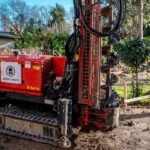Vacumetros are the state-of-the-art for precise measurement and control of vacuum levels in the dynamic domain of industrial and scientific activities. We explore the complex world of vacuum cleaners, covering topics such as basic concepts, many models, wide range of uses, and important maintenance procedures that are necessary to ensure the best possible performance.
Vacumetros, sometimes referred to as vacuum gauges, are essential tools for measuring and controlling vacuum pressure. We will examine the complex functions of vacuum cleaners, their uses in a range of sectors, and the best ways to use them in this in-depth examination.
The core idea of vacuum measurement, which is essential to everything from scientific inquiry to industrial manufacture, is at the heart of vacumetros. Vacumetros basically work on the principle of identifying and measuring the lack of substance or pressure in a closed area.
These devices provide accurate monitoring and control by detecting fluctuations in pressure levels. This makes it possible to achieve the necessary vacuum conditions, which are necessary for a variety of applications in various sectors.
Various Types of Vacumetros
Vacumetros are diverse in both form and function, and they come in a variety of varieties, each suited to certain environmental factors and operating needs. A few of the well-known variations include the Pirani, digital, mechanical, and thermal conductivity vacumetros.
Applications of Vacumetros:
Vacumetros has a broad impact on a variety of industries, including manufacturing, automotive, aerospace, and research and development. Vacumetros in the industrial sector optimize efficiency and product quality by facilitating precision control in operations like vacuum molding and packaging.
These tools are essential to the automobile industry since they evaluate engines and brake booster systems, guaranteeing maximum efficiency and safety. Vacumetros are also of great use in aerospace applications, helping to keep vacuum conditions in propulsion systems and space simulation chambers, thereby expanding the boundaries of space research.
How to Pick a Reputable Vacumetro?
A thorough assessment of several aspects, including vacuum range, accuracy requirements, compatibility, and available features, is necessary when choosing the right vacuum cleaner. The procedure entails a critical evaluation of technical specifications and performance indicators in addition to a strategic assessment of operational needs and goals.
Through the alignment of selected vacuum cleaners with the unique requirements of the intended application, stakeholders may maximize operational results and returns on investment by optimizing efficiency, dependability, and cost-effectiveness.
Installation and Maintenance:
Careful installation techniques and vigilant maintenance regimens are essential to the smooth operation and long-term integration of vacuum cleaners. Following the manufacturer’s instructions for calibration, zeroing, and operating parameter verification is necessary for a proper installation.
In order to maintain accuracy, dependability, and lifespan, frequent maintenance procedures including cleaning, calibration, and component replacement are essential. Operators may reduce the likelihood of failures, maximize efficiency, and extend the lifespan of vacuum cleaners by giving priority to preventive maintenance procedures. This approach guarantees continuous excellence in operations.
Typical Problems of Vacumetros:
Vacumetros can have problems from erroneous readings to leaks or malfunctioning sensors even with careful maintenance. Sophisticated diagnostic techniques are necessary for troubleshooting since they include evaluating connections, calibration status, and environmental factors.
Through the utilization of manufacturer resources, user manuals, and knowledge, operators can promptly detect and resolve problems, returning vacuum cleaners to peak performance and minimizing interruptions to operations.
Developments and Upcoming Trends:
Driven by unrelenting creativity and technical progress, the vacuum cleaner industry is changing. Future trends foresee the arrival of smart vacuum cleaners, which will have Internet of Things (IoT) features enabling data-driven insights, predictive maintenance, and remote monitoring.
Furthermore, the goal of downsizing efforts is to create portable and small vacumetros that may be used for a variety of purposes. Furthermore, improved sensor technologies offer increased sensitivity and accuracy, enabling vacumetros to detect ultra-low vacuum levels with previously unheard-of precision and dependability.
Safety Concerns of Vacumetros
Using vacuum cleaners entails important safety concerns, especially in high-pressure or vacuum situations. Strict adherence to safety standards, which include emergency protocols, protective gear use, and operator training, is necessary to protect workers and reduce possible risks.
In addition, thorough risk assessment and hazard mitigation plans guarantee adherence to industry best practices and regulatory requirements, promoting a culture of accountability, safety, and operational excellence.
A thorough comparative study that takes into account features like accuracy, dependability, affordability, and feature sets is necessary to navigate the many alternatives available in vacuum cleaners.
Case Studies:
Empirical case studies provide powerful evidence of the effectiveness and adaptability of vacuum cleaners in a range of industries and applications. These real-world examples highlight occasions when the strategic integration of vacuum cleaners resulted in increased productivity, simpler procedures, and cost savings.
Case studies highlight the revolutionary influence of vacuum cleaners in fostering innovation, productivity, and competitiveness in a variety of industries, including semiconductor production and food sector vacuum packing.
Conclusion
vacuum meteorologists are essential instruments at the forefront of vacuum measurement and control, supporting a wide range of scientific and industrial procedures. Through a thorough understanding of vacumetros, including their fundamental principles, cutting-edge trends, and safety considerations, stakeholders may uncover potential for increased productivity, efficiency, and safety.
By means of strategic selection, rigorous maintenance, and proactive troubleshooting, stakeholders effectively leverage the full potential of vacuum cleaners, hence promoting innovation and propelling technological and scientific frontiers.
FAQ’s
What is vacumetros?
By identifying the absence of substance or pressure within a limited space, vacuum metrologists are vital instruments used to accurately measure and manage vacuum levels in industrial and scientific activities.
What kind of vacuum cleaners are offered?
Vacumetros come in a variety of varieties, each suited to certain environmental factors and operating requirements. These include mechanical, digital, thermal conductivity, and Pirani vacumetros.
How can I pick the best vacuum cleaner?
Selecting the appropriate vacuum cleaner necessitates assessing variables such as vacuum range, precision needs, compatibility, and functionalities to match the device to certain operational requirements for maximum efficiency.
How should I respond if I have typical problems with vacuum cleaners?
Vacumetros frequently experience problems that may be resolved by systematic diagnostics, using resources from the manufacturer, and studying user manuals for advice on troubleshooting. Examples of these problems include erroneous readings or malfunctioning sensors.
Which vacumetro developments may we expect in the future?
Vacumetros’ future developments will focus on downsizing for smaller designs, smart features with IoT integration, and improved sensor technologies for more sensitive and accurate ultra-low vacuum level detection.
How can vacumetros promote creativity and efficiency?
Real-world case studies demonstrating the transformational influence of vacumetros demonstrate how they provide precise control in a variety of processes, enhance productivity, streamline operations, and realize cost savings across varied sectors. All of these benefits promote efficiency and creativity in the workplace.
How are vacumetros used in current research and technology?
Vacumetros play a crucial role in modern technology and research, supporting a wide range of industrial and scientific processes by precisely measuring and controlling vacuum levels, improving productivity, safety, and efficiency, and advancing the boundaries of scientific knowledge.







